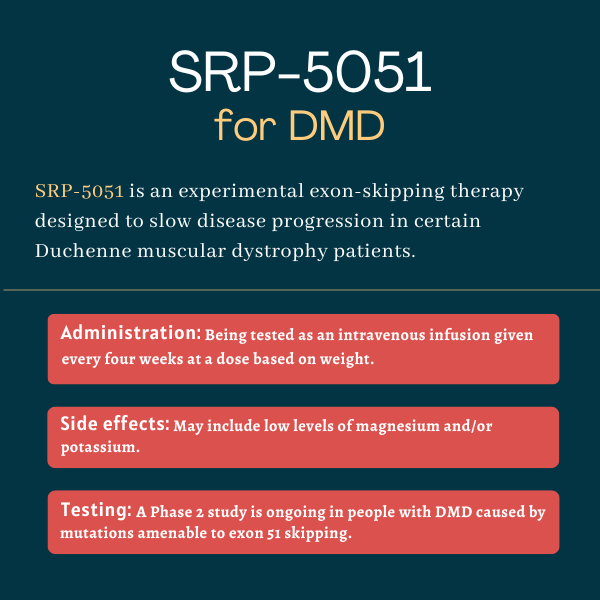SRP-5051 for Duchenne muscular dystrophy
Last updated July 23, 2024, by Marisa Wexler, MS

What is SRP-5051 for Duchenne muscular dystrophy?
SRP-5051 (vesleteplirsen) is an exon-skipping therapy being developed to treat people with Duchenne muscular dystrophy (DMD) who have mutations amenable to exon 51 skipping.
It is designed to increase production of dystrophin and slow disease progression in eligible patients, who account for about 13% of all people with DMD.
The experimental therapy, from Sarepta Therapeutics, is given intravenously, or via an infusion directly into the bloodstream.
Therapy snapshot
| Treatment name: | SRP-5051 |
| Administration: | Intravenous infusion |
| Clinical testing: | Being investigated in a Phase 2 trial |
How does SRP-5051 work?
DMD is caused by mutations in the DMD gene, which codes for a protein called dystrophin that normally acts like a shock absorber to cushion muscle cells, preventing wear and tear during movement.
Protein-coding genes like DMD are composed of exons — the regions of DNA that actually code for the protein — that are interspersed with non-coding regions called introns. When a gene is read during the production process, the genetic code, including exons and introns, is copied into a temporary molecule called messenger RNA, or mRNA. The mRNA is then edited to remove all the introns, and exons are glued together to form a mature mRNA molecule that can be used to make a protein.
When genetic code is read, the nucleotides — the building blocks or letters of code — are grouped into clusters called codons, somewhat analogous to how letters are grouped into words in a sentence.
Some DMD-causing mutations can result in a frameshift, where all the subsequent codons get out of alignment. As an example, imagine removing the last letter from every word in a sentence, and adding it to the start of the next word. Here, the result is that the remaining part of the gene becomes nonsensical, so only the first portion of the protein is made, resulting in an unstable product that is quickly degraded in the cell.
In patients with specific mutations, skipping exon 51 of the DMD gene can fix the frameshift mutation, allowing the cell to correctly read the code downstream of the mutation. By skipping exon 51, the cell can make a shortened, but still functional, version of dystrophin.
SRP-5051 contains a lab-made DNA or RNA molecule that masks exon 51 and promotes its removal from the DMD mRNA, effectively skipping the exon.
It is designed to work similarly to Exondys 51 (eteplirsen), an older exon 51-skipping therapy developed by Sarepta. But SRP-5051 is a next-generation version that has been modified with a small protein, or peptide, that allows the therapy to more effectively get inside muscle cells.
How will SRP-5051 be administered in DMD?
SRP-5051 is designed to be administered via intravenous or IV infusions. In DMD clinical trials, infusions of SRP-5051 were given once every four weeks, and early clinical data suggested that a target dose of 30 milligrams per kilogram of body weight (mg/kg) may provide the greatest benefits.
This dosing schedule is a notable difference from the older treatment Exondys 51, which is given in weekly infusions. However, it is too early to know whether this will be the selected dose and regimen if and when the therapy is ultimately approved by regulatory authorities.

SRP-5051 in clinical trials
SRP-5051 was tested in a Phase 1 clinical trial (NCT03375255) involving DMD patients 12 and older. A Phase 2 trial called MOMENTUM (NCT04004065) is ongoing in boys and young men with DMD. Participants in these trials were all amenable to exon 51 skipping.
Phase 1 trial
The Phase 1 trial recruited 15 DMD patients at sites in the U.S. and Canada, who were given a single infusion of SRP-5051, at one of five dose levels. The primary outcome was the number of participants with side effects after up to 14 weeks, or about three months, but researchers also examined the therapy’s pharmacological properties.
The study finished in August 2019, but detailed results have not yet been released.
MOMENTUM Phase 2 trial
Sarepta now is sponsoring the two-part MOMENTUM trial to further explore the efficacy, safety, and pharmacological properties of SRP-5051. In Part A, participants were given monthly infusions of SRP-5051, starting at a dose of 4 mg/kg and increasing to 40 mg/kg, over 12 weeks.
Results from Part A indicated that SRP-5051 was generally well tolerated at all studied doses, with no serious adverse effects reported. The treatment also consistently increased exon-skipping and dystrophin protein levels.
Comparisons against results from the PROMOVI Phase 3 study (NCT02255552), in which all participants received Exondys 51, indicated that a 30 mg/kg dose of SRP-5051, given monthly for three months, increased dystrophin levels by about eight times more than did Exondys 51 given weekly for six months.
Results from Part A were used to determine the optimal dosing for Part B, in which participants are receiving monthly infusions of SRP-5051 at doses of either 20 or 30 mg/kg, for up to five years. The main goal is to assess how the use of SRP-5051 affects levels of dystrophin protein in patients’ muscles after about six months of treatment.
Part B included 40 children and young adults, ages 8 to 21. After six months on the therapy, patients given the higher dose had dystrophin protein levels at 5.17% of normal, the results showed. To put that in perspective, dystrophin levels were 0.82% of normal in the PROMOVI trial of Exondys 51 after a similar period.
Safety data in Part B of MOMENTUM were generally positive. The U.S. Food and Drug Administration placed a hold on the study in 2022 following a severe case of abnormally low magnesium levels (hypomagnesemia), but the hold was lifted a few months later and the study resumed with extra safety precautions in place.
Common side effects of SRP-5051
Serious cases of hypomagnesemia and hypokalemia, or low potassium levels, have been reported for patients on SRP-5051 in the MOMENTUM Phase 2 trial. Hypomagnesemia also has been seen in earlier studies of SRP-5051, according to Sarepta.
Muscular Dystrophy News Today is strictly a news and information website about the disease. It does not provide medical advice, diagnosis, or treatment. This content is not intended to be a substitute for professional medical advice, diagnosis, or treatment. Always seek the advice of your physician or other qualified health provider with any questions you may have regarding a medical condition. Never disregard professional medical advice or delay in seeking it because of something you have read on this website.
Recent Posts
Related articles





